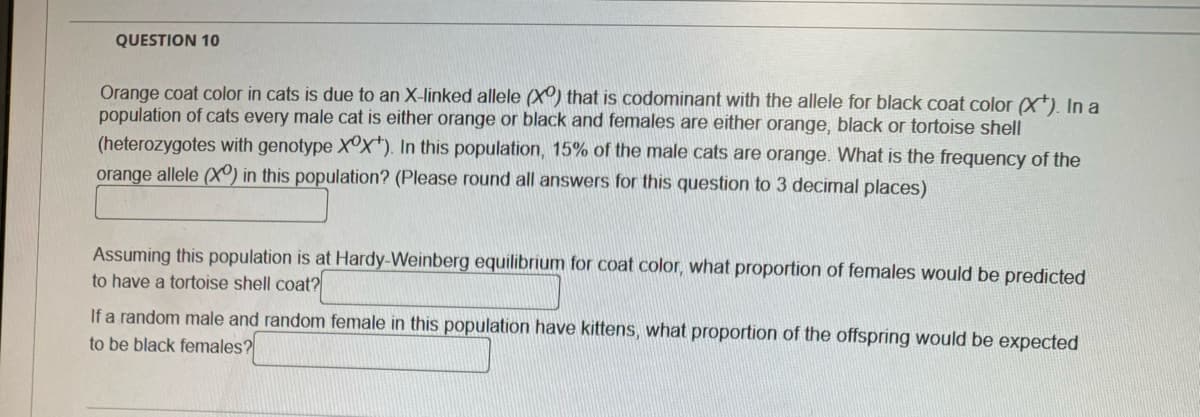QUESTION 10 Orange coat color in cats is due to an X-linked allele (X) that is codominant with the allele for black coat color (X+). In a population of cats every male cat is either orange or black and females are either orange, black or tortoise shell (heterozygotes with genotype XOX+). In this population, 15% of the male cats are orange. What is the frequency of the orange allele (X) in this population? (Please round all answers for this question to 3 decimal places) Assuming this population is at Hardy-Weinberg equilibrium for coat color, what proportion of females would be predicted to have a tortoise shell coat? If a random male and random female in this population have kittens, what proportion of the offspring would be expected to be black females?
QUESTION 10 Orange coat color in cats is due to an X-linked allele (X) that is codominant with the allele for black coat color (X+). In a population of cats every male cat is either orange or black and females are either orange, black or tortoise shell (heterozygotes with genotype XOX+). In this population, 15% of the male cats are orange. What is the frequency of the orange allele (X) in this population? (Please round all answers for this question to 3 decimal places) Assuming this population is at Hardy-Weinberg equilibrium for coat color, what proportion of females would be predicted to have a tortoise shell coat? If a random male and random female in this population have kittens, what proportion of the offspring would be expected to be black females?
Human Anatomy & Physiology (11th Edition)
11th Edition
ISBN:9780134580999
Author:Elaine N. Marieb, Katja N. Hoehn
Publisher:Elaine N. Marieb, Katja N. Hoehn
Chapter1: The Human Body: An Orientation
Section: Chapter Questions
Problem 1RQ: The correct sequence of levels forming the structural hierarchy is A. (a) organ, organ system,...
Related questions
Topic Video
Question

Transcribed Image Text:QUESTION 10
Orange coat color in cats is due to an X-linked allele (X) that is codominant with the allele for black coat color (X). In a
population of cats every male cat is either orange or black and females are either orange, black or tortoise shell
(heterozygotes with genotype XOX+). In this population, 15% of the male cats are orange. What is the frequency of the
orange allele (X) in this population? (Please round all answers for this question to 3 decimal places)
Assuming this population is at Hardy-Weinberg equilibrium for coat color, what proportion of females would be predicted
to have a tortoise shell coat?
If a random male and random female in this population have kittens, what proportion of the offspring would be expected
to be black females?
Expert Solution
This question has been solved!
Explore an expertly crafted, step-by-step solution for a thorough understanding of key concepts.
Step by step
Solved in 3 steps

Knowledge Booster
Learn more about
Need a deep-dive on the concept behind this application? Look no further. Learn more about this topic, biology and related others by exploring similar questions and additional content below.Recommended textbooks for you

Human Anatomy & Physiology (11th Edition)
Biology
ISBN:
9780134580999
Author:
Elaine N. Marieb, Katja N. Hoehn
Publisher:
PEARSON

Biology 2e
Biology
ISBN:
9781947172517
Author:
Matthew Douglas, Jung Choi, Mary Ann Clark
Publisher:
OpenStax

Anatomy & Physiology
Biology
ISBN:
9781259398629
Author:
McKinley, Michael P., O'loughlin, Valerie Dean, Bidle, Theresa Stouter
Publisher:
Mcgraw Hill Education,

Human Anatomy & Physiology (11th Edition)
Biology
ISBN:
9780134580999
Author:
Elaine N. Marieb, Katja N. Hoehn
Publisher:
PEARSON

Biology 2e
Biology
ISBN:
9781947172517
Author:
Matthew Douglas, Jung Choi, Mary Ann Clark
Publisher:
OpenStax

Anatomy & Physiology
Biology
ISBN:
9781259398629
Author:
McKinley, Michael P., O'loughlin, Valerie Dean, Bidle, Theresa Stouter
Publisher:
Mcgraw Hill Education,

Molecular Biology of the Cell (Sixth Edition)
Biology
ISBN:
9780815344322
Author:
Bruce Alberts, Alexander D. Johnson, Julian Lewis, David Morgan, Martin Raff, Keith Roberts, Peter Walter
Publisher:
W. W. Norton & Company

Laboratory Manual For Human Anatomy & Physiology
Biology
ISBN:
9781260159363
Author:
Martin, Terry R., Prentice-craver, Cynthia
Publisher:
McGraw-Hill Publishing Co.

Inquiry Into Life (16th Edition)
Biology
ISBN:
9781260231700
Author:
Sylvia S. Mader, Michael Windelspecht
Publisher:
McGraw Hill Education